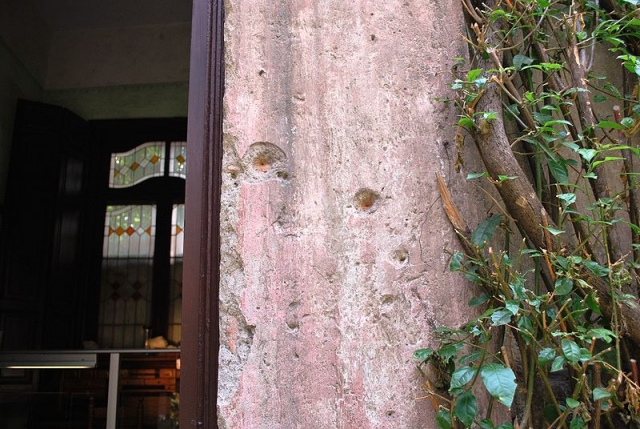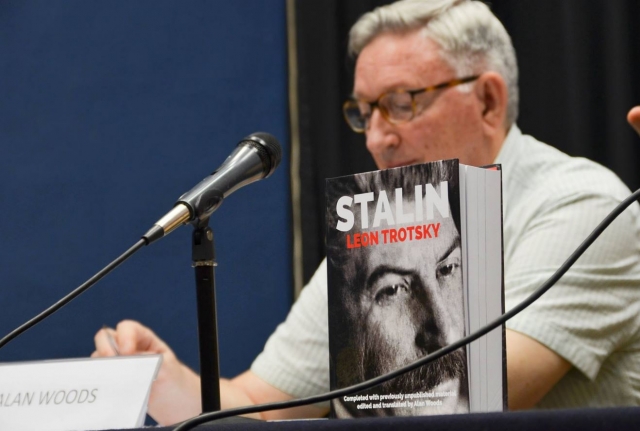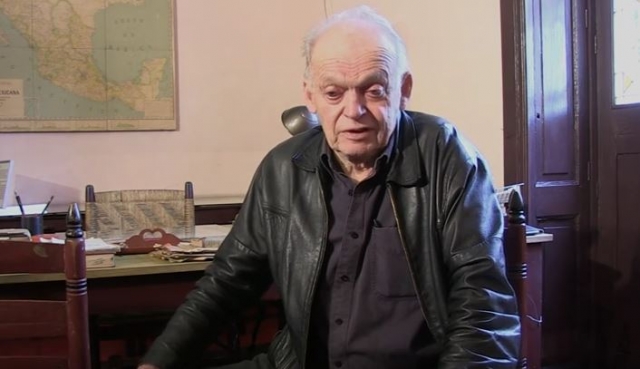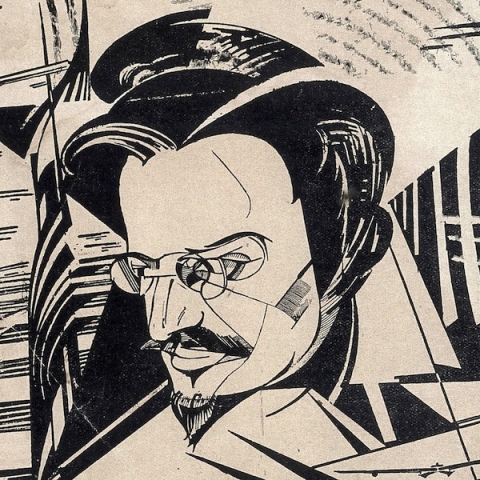On 30 October we reported that the Spanish daily El País had published a review of the new edition of Trotsky's biography of Stalin (available at WellRed Books). The review appeared prominently in the popular Sunday supplement of El País, which is read by millions of people worldwide. Today we are pleased to present an English-language translation.
The author of the article, Bernardo Marín, deputy editor of El País, interviewed the editor of www.marxist.com, Alan Woods, who reassembled and edited the new edition – as well as Esteban Volkov, the grandson of Leon Trotsky. El País is the largest-circulation printed paper in Spain and the first online newspaper in Spanish in the world with over 11 million unique readers every month.
The article was also printed in the Portuguese language edition of the paper. It has aroused a lot of interest, which is shown by the fact that it was the article in that edition of the paper that people took most time to read. Since its publication there has been a noticeable increase in orders for the book from people in Spain and other countries.
The Spanish edition of this important work, containing a large amount of material that has never been published before, is approaching completion and is due to be launched in meetings in Madrid, Barcelona and Vitoria in the last week of November, when it will be presented to the public by Alan Woods. It can be obtained from the publishers, Editorial Lucha de Clases.
Next week Alan will be in Mexico where he will launch the Mexican edition of Stalin (by Fontamara) as part of a series of meetings organized by Esteban Volkov and the Trotsky Museum to celebrate the hundredth anniversary of the October Revolution.
The original Spanish-language article can be found here. We would like to thank Bernardo Marín and El País for granting permission for the republication of this article.
In Defence of Marxism
Portrait of my killer
Stalin's – largely unpublished – biography was being written by Trotsky when he was assassinated at the behest of the subject of the biography.
“Stalin had fun in his country house, slaughtering sheep or pouring kerosene in the anthills and setting them on fire. Kamenev told me that in his Saturday leisure visits to Zubalovka, Stalin walked through the woods and continually amused himself by shooting wild animals and scaring the local population. Such stories about him, coming from independent observers, are numerous. And yet, there is no shortage of people with these kinds of sadistic tendencies in the world. Special historical conditions were necessary before these dark instincts found such a monstrous expression.”
These words are part of a unique biography. Unique because of the significance of its protagonists: two of the most prominent figures of the Russian Revolution, facing each other in one of the most bitter rivalries of the twentieth century. And because the profile remained unfinished after the portrayed ordered the death of his biographer. Stalin, the work that Leon Trotsky was writing when he was murdered by Ramón Mercader in Mexico in August 1940, has remained dormant for more than seven decades. And after many vicissitudes, mutilations and additions, it again sees the light in a volume of almost a thousand pages – largely never-before published – coinciding with the centenary of the Bolsheviks' rise to power.
The history of this book deserves the publication of another to tell it. Trotsky, exiled in Mexico after being denied asylum in several countries, knew he had been placed under sentence of death by the leader of the Soviet Union, Joseph Stalin. But he had no particular interest in writing about the life of his old comrade. "It was not out of revenge. Writing this biography did not fit into grandpa's plans. He was focused on finishing another [biography] of Lenin," explains Esteban Volkov, grandson of the revolutionary, in a telephone conversation from Mexico City, where he resides. "But he needed money and Harper & Brothers in New York made him a generous offer."

Volkov, about to turn 92, has been the guardian of his grandfather's memory for decades. He is also director of the Leon Trotsky House Museum, within whose walls the revolutionary was assassinated in August 1940 by a piolet [ice-pick] blow, delivered by the Stalinist agent, Ramón Mercader. The Spanish version of the book, published by the Mexican publisher Fontamara, will be launched in this same setting on the 11th; coinciding with the anniversary of the October Revolution that, due to differences between the Gregorian and Julian calendars, happened in November for the rest of the world. The work was published a year ago in English by a Marxist publishing house in London and was later translated into Italian and Portuguese, but the news of the publication had no impact on the mainstream media.
Harper & Brothers published an incomplete version of the book in English in 1946. Prior to this, publication was impossible, because the US and the Soviet Union were allies against Germany. But Trotsky's widow, Natalia Sedova, sued the publisher in court, without success, in an attempt to have the book withdrawn. Her objections were addressed, above all, against the editor and translator of the work. "He produced a deficient edition of the book, with mutilations and multiple additions of his own far removed from my grandfather's political thought," explains Volkov. Trotsky himself never had much confidence in his translator, and had a fit of rage when he learned that he had shown some originals to third parties. "He seems to have at least three qualities: that he does not know Russian, that he does not know English and that he is tremendously pretentious," he wrote in a letter to US journalist Joseph Hansen.
But part of the work never reached the publisher's hands. When he realised he was sentenced to death, Trotsky sent many of his documents to Harvard University in the United States for safekeeping. "The archives leave this morning by train," the revolutionary wrote on 17 July 1940, one month and three days before his murder. And there, 20,000 documents were accumulated, comprising of 172 boxes of articles, photographs and manuscript papers – typed, translated and untranslated – with a large number of corrections that showed how extraordinarily meticulous he was with his work.
Entire chapters of the book thus remained dormant until in 2003, when the Welsh historian Alan Woods began to dig into the mountain of documents to rescue the broadest and fullest possible version of the book [small correction: it was Rob Sewell, editor of Socialist Appeal (UK paper of the IMT), who obtained these documents from Harvard. Both he and Woods worked together on the book, with Woods serving as the main translator]. And after more than ten years of labour, the result was a work a third longer than the book published in the 40s, without the additions of the first translator and, now, with the blessings of Trotsky's family.
Woods agrees with Volkov that Trotsky did not want to write this book. "But once he got to it, he did it conscientiously, with a lot of documentation and details of even the most unknown period of Stalin's life, his childhood. For any reader it is a fascinating psychological study, " he explains from London, where he resides. The historian is an active member of the International Marxist Tendency. He participated in the struggle against the Franco regime in Spain and was a strong supporter of the Bolivarian revolution and a personal friend of Hugo Chávez, although in recent times he has distanced himself from the drift of the Venezuelan government.
 Alan Woods with Stalin biography / Image: Marxist.com
Alan Woods with Stalin biography / Image: Marxist.com
The leaders of the Bolshevik Party were generally very capable people, and among them shone Trotsky, who mastered five languages and wrote several books at once. Stalin appears instead portrayed by his great political rival as a man of limited horizons. This mediocre profile coincides with that of other observers, such as the American journalist John Reed, who in his chronicle Ten Days that Shook the World mentions The Man of Steel only twice and Trotsky no less than 67 times.
But, from what is told in the book now presented, Stalin did possess qualities of cunning and the art of manipulation:
"Stalin's technique consisted in gradually advancing step by step towards the position of dictator, while representing the role of a modest defender of the Central Committee and collective leadership. He thoroughly used Lenin's period of illness to promote individuals who were devoted to him. He took advantage of every situation, of every political circumstance, of any combination of people to promote his own advancement that would help him in his struggle for power and achieve his desire to dominate others. If he could not rise to their intellectual height, he could provoke a conflict between two stronger competitors. He elevated the art of manipulating personal or group antagonisms to new heights. In this field he developed an almost infallible instinct."
However, Woods does not attribute Stalin's rise to power to his character. "He was a child abused by his father, spiteful and with sadistic tendencies. But not all the abused become monsters. As not all unsuccessful artists become Hitler." And he proposes a Marxist argument to explain his rise. "In all revolutions there is a period that needs heroes, giants. When you reach a period of decline, you need the mediocre. The bureaucratic degeneration would have taken place with or without Stalin, because Russia was an isolated and backward country. But in this case the bureaucracy was embodied in a bloodthirsty character."
Could the book have accelerated the murder? Stalin was very well informed of what his rival was doing. Every morning he had Trotsky's latest articles on his desk. And Volkov recalls how Robert Sheldon Harte, bodyguard of his grandfather to whom is attributed the betrayal that facilitated a first attack against him in May 1940, was always asking him about the progress of the work. "Like any criminal, he had to eliminate witnesses," Woods agrees.
BLOOD ON PAPER
by Jorge F. Hernández
The most transcendental biography of Joseph Vissarionovich, sadly still celebrated by some by his nickname, Stalin, is a meticulous portrait of the diabolical Russian dictator in 890 pages, written by no other than Leon Davidovich Bronstein, who we know as Trotsky. It seems incredible that the publication in English a year ago has not produced headlines, a stir in the networks or a series of reviews. We live in a state of amnesia, which some seem to believe can be quenched in the space of 140 characters. At least two generations only know of Leon Trotsky from films, postcards and coffee mugs and other products circulating since Frida Kahlo became a registered trademark.
The immense biography, signed by one of the main leaders of the Russian Revolution, surgically deconstructs the incredible dementia of a bloodthirsty traitor of that same revolution: an animal who would seem inconceivable were it not for thousands of documents, photographs (even those altered ‘for the sake of History ‘), testimonies, survivors of the purges, castaways of the Gulag, redeemed outlaws and repentant followers who even from the first Bolshevik triumph left a record of their trail of misfortunes and constant compendium of crimes. Among the paragraphs that Trotsky outlined during his tireless exile in his fragile fortress of Coyoacán, the papers that would be his gravestone were on the table, whose writing was interrupted as soon as Ramón Mercader buried his mountaineer’s piolet in the author’s skull.
Trotsky struggled with the assassin, knowing that his executioner was smiling in the Kremlin and perhaps during his agony he thought that at least a large part of the scrupulous biography of his executioner – and that of most of his family, of millions of human beings and of not a few utopian illusions – were almost finished. He had agreed to write it for the sizable payment promised by an American publisher, whose translator went on to mis-translate, edit and even amend and add paragraphs of his own. That has been corrected and we now have the publication of a portrait of the Devil made in prose on papers...stained with blood.
ESTEBAN VOLKOV: "ONE OF STALIN'S MAJOR CRIMES WAS TO MUTILATE HISTORICAL MEMORY"
B.M
Esteban Volkov (Yalta, then Soviet Union, 1926), grandson of Leon Trotsky and heir to his legacy, is preparing in these days events to commemorate the centenary of the Russian Revolution in Mexico City, where he presides over the House Museum in which his grandfather was killed. There he arrived in 1939 to accompany Trotsky in his exile when he was just a teenager, after his father disappeared in the Gulag and his mother died following harassment by Stalin's assassins. He was wounded in the foot in an attack organised by the painter David Alfaro Siqueiros, to end the life of the revolutionary in May 1940 and a few months later he witnessed the agony of his grandfather after being attacked by Ramón Mercader. Despite the terrible events that he has witnessed, he maintains a serene spirit and an enviable mood, and at 91 years of age he says he hopes to live many more years "to compensate for all the years that Stalin stole from his family".

You have devoted a large part of your life and energy to defend the memory of your grandfather. What has moved you to do it?
I witnessed his murder and the slander and defamation campaign against him from the Stalinist press. Lies that were repeated a thousand and one times, to try to turn them into truths. One of Stalin's greatest crimes has been to mutilate historical memory. If it is a crime to give a false map to an explorer who is going to enter the Amazon, giving false maps to humanity is an even more serious crime. Leaving the human race with a blindfold over its eyes, while travelling amongst deep chasms, is one of the worst crimes that can be committed.
What is the value of publishing Trotsky’s biography of Stalin so many years later?
It was not the book that my grandfather wanted to write, and he did it because of the economic difficulties. But it is very interesting, because it was written at a time of Trotsky’s great political maturity and relates the environment in which a man with the characteristics of Stalin, who falls below the ethical standards of anyone, can come to power. There is no doubt that he was a sui generis individual, possessing a cruelty that has seldom been seen in history. Characters like Nero or Attila look small by comparison. And that's why he possibly accelerated the death sentence he had issued against my grandfather when he learned that his biography was being written.
What remains of Trotsky's thought one hundred years after the Russian Revolution?
My grandfather left an arsenal of political ideas to change society. To build a world that cares about human beings and not greed. He studied thoroughly the Stalinist regime and the counterrevolution. And he predicted 70 years in advance the fall of bureaucratic totalitarianism in the Soviet Union.

